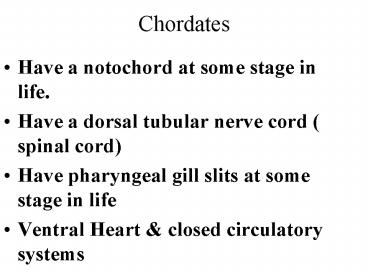Chordates - PowerPoint PPT Presentation
1 / 85
Title:
Chordates
Description:
Have pharyngeal gill slits at some stage in life. Ventral ... ANADROMOUS-RETURN TO FRESH WATER TO SPAWN. Agnatha cont. LATERAL LINE-senses vibrations in water ... – PowerPoint PPT presentation
Number of Views:62
Avg rating:3.0/5.0
Title: Chordates
1
Chordates
- Have a notochord at some stage in life.
- Have a dorsal tubular nerve cord ( spinal cord)
- Have pharyngeal gill slits at some stage in life
- Ventral Heart closed circulatory systems
2
Chordate subphyla
- Urochordata- Tunicate sea squirt(Amocetes larvae)
- Cephalochordata- Amphioxus or lancelet
- hemichordata - acorn worm
- Vertebrata- animals with at least some vertebrae
of bone or cartilage 8 classes
3
(No Transcript)
4
(No Transcript)
5
AGNATHA
- JAWLESS PARASITE
- NOTOCHORD IS PRIMARY SUPPORT
- UNPAIRED FINS
- POILKIOTHERMIC- UNABLE TO MAINTAIN CONSTANT BODY
TEMPERATURE - OPEN GILLS
- 2 CHAMBERED HEART
- ANADROMOUS-RETURN TO FRESH WATER TO SPAWN
6
(No Transcript)
7
(No Transcript)
8
(No Transcript)
9
Agnatha cont.
- LATERAL LINE-senses vibrations in water
10
Open Gill Slits Pineal organ
11
Pineal Organ
- Senses light direct migration and mating
behavior according to seasonal changes in light
12
Notochord Gill
13
Notochord
- Dorsal rod-like support
14
Curved Horny Teeth
15
Round Circular Mouth
16
(No Transcript)
17
CHONDRICHTHYES
18
(No Transcript)
19
- OVOVIVIPAROUS-BEAR LIVE YOUNG THAT ARE NOURISHED
FROM YOLK - SHARKS, RAYS, AND SKATES
- 2 CH. HEART, Poilkiothermic
- SPIRACLE, OPEN GILLS,
20
- CARTILAGE SKELETON
- RECTAL GLAND- REMOVES SALT
- OIL CONTENT HIGH FOR BUOYANCY
- PLACOID SCALE-TOOTH LIKE
21
(No Transcript)
22
(No Transcript)
23
(No Transcript)
24
(No Transcript)
25
Spiracle Gill Slits
26
Spiracle
- Takes in water
- Gills are open
- Flap of skin folds back over but does not close
as in body fish
27
(No Transcript)
28
(No Transcript)
29
Rectal Gland Removes Salt
30
(No Transcript)
31
Gill Raker and Lamellae
32
- Raker -removes food and dirt
- Lamellae- rremoves oxygen from water and carbon
dioxide from bloodgas is exchanged
33
OSTEICHTHYES
- OPERCULUM-GILL COVER
- BONY SKELETON
- SWIM BLADDER-buoyancy
- FLAT CTENOID OR CYCLOID SCALES
- MOST ARE OVIPAROUS-LAY EGGS
34
Ostiechthyes cont
- 2 CHAMBERED HEART
- LATERAL LINE-senses vibrations in water
- POILKIOTHERMIC
35
(No Transcript)
36
(No Transcript)
37
(No Transcript)
38
(No Transcript)
39
(No Transcript)
40
To Gills
Oxygenated and Deoxygenated is mixed
41
Heart chambers
- Atria- collects and pushes blood into ventricle
- Ventricle- pumps blood to body or lungs
42
(No Transcript)
43
(No Transcript)
44
(No Transcript)
45
AMPHIBIA
- SMOOTH MOIST SKIN, POISON GLANDS PIGMENT CELLS
- TETRAPODS ( MOSTLY) LACK CLAWS
- TYMPANUM VOCAL SACS
- LUNGS, GILLS, CUTANEOUS (SKIN ) BREATHING
- 3 CHAMBERED HEART
- POIKIOTHERMIC
46
(No Transcript)
47
(No Transcript)
48
(No Transcript)
49
Tympanum
- External ear drum
- Vocalize during courtship and for establishing a
territory
50
(No Transcript)
51
(No Transcript)
52
(No Transcript)
53
(No Transcript)
54
(No Transcript)
55
(No Transcript)
56
(No Transcript)
57
(No Transcript)
58
REPTILIA
- Thick, dry keratinized scales with claws, four
limbs - Poilkiotherms( ectotherms)
- Amniote eggs- water built inside or ovoviviparous
or oviparous - Lungs
- Jacobsons organ-smell or taste
- Infared Pit- heat sensation
59
Nictitating Membrane
- Second eyelid transparent
60
(No Transcript)
61
(No Transcript)
62
(No Transcript)
63
(No Transcript)
64
Four chambers with incomplete septum
65
(No Transcript)
66
(No Transcript)
67
(No Transcript)
68
AVES
- Feathers, beak, scales, keeled sternum, hollow
bones, synsacrum, fused phalanges- wings, highest
metabolism, crop, gizzard, and cloaca. - Amniote Eggs
- Four heart chambers
- Homeotherm- constant body temp.
- Lungs with air sacs
69
(No Transcript)
70
(No Transcript)
71
(No Transcript)
72
(No Transcript)
73
(No Transcript)
74
(No Transcript)
75
(No Transcript)
76
(No Transcript)
77
(No Transcript)
78
(No Transcript)
79
(No Transcript)
80
(No Transcript)
81
Mammalia
- Homeothermic
- 4 Complete Heart Chambers
- Hair covers body
- Mammary Glands
- Mostly Viviparous- mostly placental
82
Adaptations for survival in Terrestrial
Environments Skeleton RespiratoryGills and
cutaneous breathing to Lungs Circulatory
Separation of Heart chambers Sensory- lens,
tympanum,touch receptors, Water Conservation-
Amniote Egg has its own water and
protection Marsupial and Placental Development
protection, Nourishment, and water.
83
Brain Regions
- Anterior to Posterior
- Olfactory-smell
- Cerebrum-thinking, learning
- Optic- vision
- Cerebellum-coordination and balance
- Medulla-breathing and heart beat regulation
84
Integument- thick keratinized scale, feathers and
skinPrevent evaporation
85
Kidneys- kidneys become better able to conserve
water by increasing their abilities to reabsorb
water and eliminate increasing concentrated or
altered nitrogen waste































